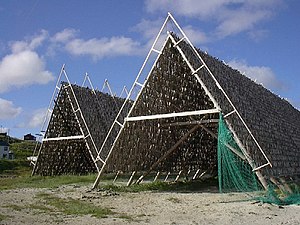Stockfish
unsalted fish preserved by drying in cold air and wind
Stockfish is the product of drying fish. In many northern countries, fish is dried to make it last longer without going bad. The dried fish is put on wooden racks,[1] It is exposed to air and wind. No salt is used. The wooden racks are called "hjell" in Norway. They are located on the foreshore.

The drying of food is the world's oldest known preservation method. Dried fish have a storage life of several years. The method is cheap and effective in suitable climates; the work can be done by the fisherman and family. The resulting product is easily taken to a market to be sold.
Gallery
change-
Cod hung for drying in Lyngen fjord, Norway
-
Stockfish up for drying in Iceland
-
Women working with stock fish in Iceland c. 1915
-
Indian village showing the native method of drying salmon, c. 1888.
-
Stomach of a sea lion used by Aleut natives to store dried red salmon
References
change- ↑ Kurlansky, chapter 3
Further reading
change- Kurlansky, Mark (1997). Cod: A Biography of the Fish That Changed the World. New York: Walker. ISBN 0-8027-1326-2ISBN 0-8027-1326-2.
- Silva, António J. M. da, In the Shadow of the Salt Cod. Writing vs Staging the Stockfish History in the Iberian Peninsula, TAE - Trabalhos de Antropologia e de Etnologia , vol. 61, 2021, pp. 167–209. PDF
- http://www.safetrackfood.eu/ Archived 2014-11-29 at the Wayback Machine